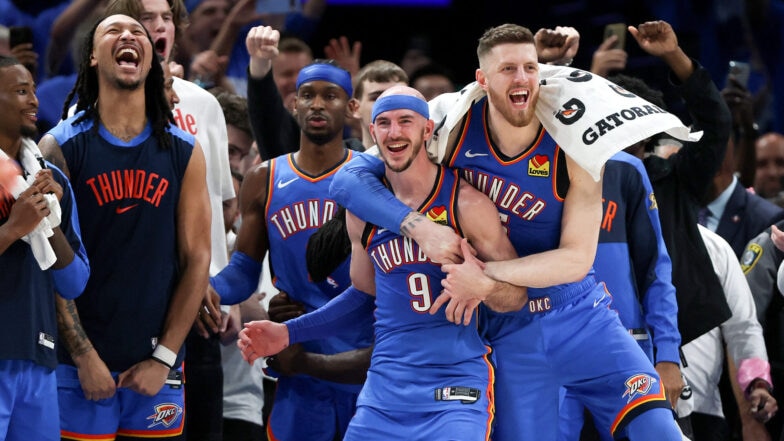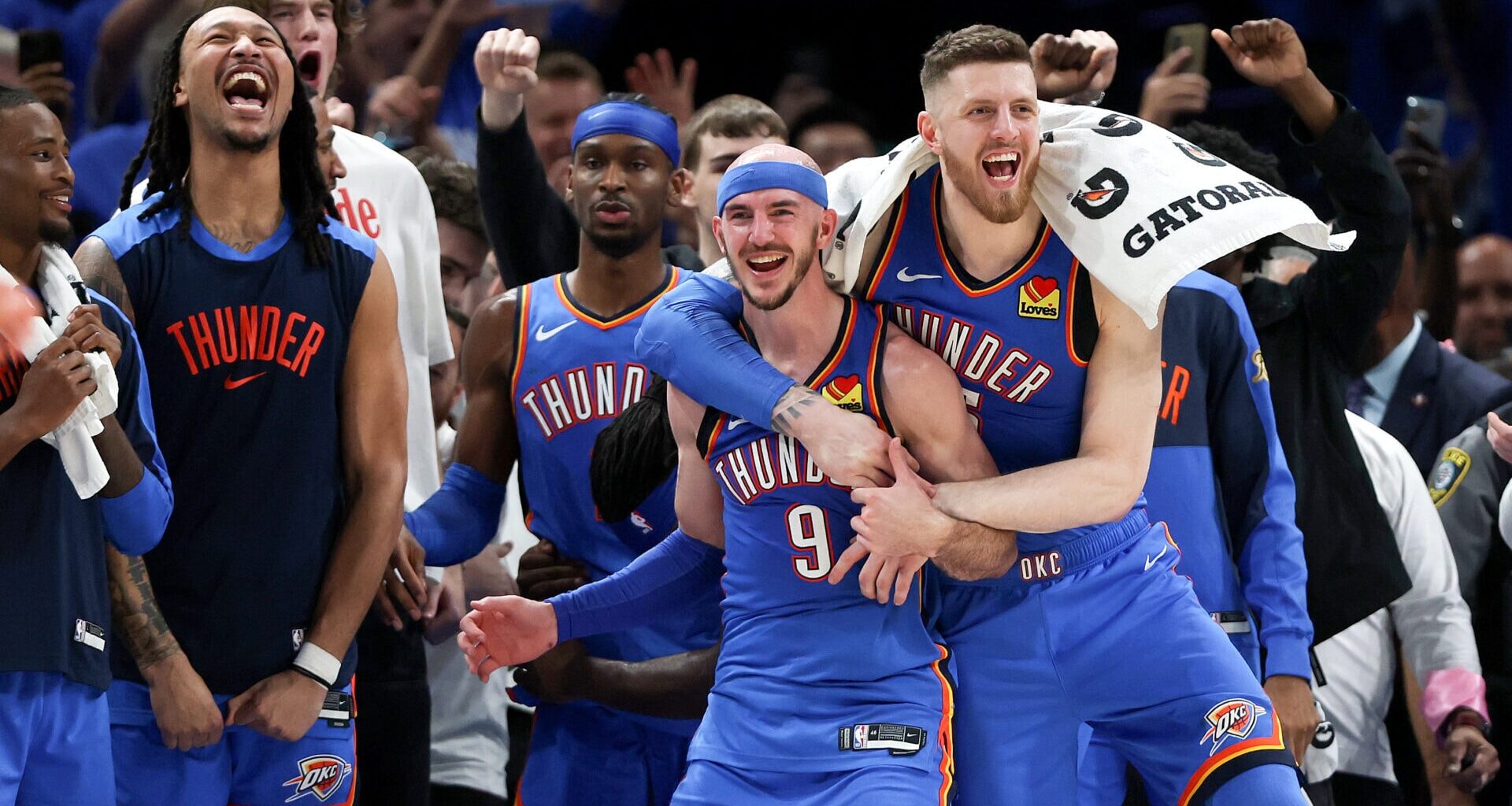
Editor’s Note: Read more NBA coverage from The Athletic here. The views on this page do not necessarily reflect the views of the NBA or its teams.
***
OKLAHOMA CITY — A few hours before Thunder guard Alex Caruso hoisted his second Larry O’Brien trophy, the 31-year-old positioned himself in the right corner of Paycom Center on Sunday, both of his feet firmly planted in the ground.
Technically, Caruso was only here to warm up and get shots up before Game 7. But the veteran was less concerned with the mechanics of his jump shot and more engrossed with the mechanics of his footwork.
Each sequence was the same; left foot back one step, right foot back two steps, catch, shoot. The motions Caruso made were deliberate, like he had been rigorously studying the latest TikTok dance. But more importantly, Caruso was present in the moment — away from the rising temperature in the arena and the anxiety building up to the biggest game of the Thunder’s lives.
Caruso was simply where his feet were.
It’s a mantra that Oklahoma City has adopted. Being cognizant of the moment, whatever moment it is, supersedes anything else. And it’s especially pertinent to Caruso, the Thunder’s most dependable two-way player, the happy medium between small ball and size and the X-factor to head coach Mark Daigneault’s system. Shai Gilgeous-Alexander is the water that carries this organization on a nightly basis, but Caruso is the straw that stirs the drink. Without him, none of this works. The smartest players learn early on what their role is and maximize it to the fullest capacity. Caruso, now a two-time NBA champion, is that.
“I think just through my career, I figured out that I can do stuff that’s not necessarily sexy or not necessarily the mainstream offensive or even defensive skill set that people recognize,” Caruso said. “I just leaned into it. I practiced being great at the stuff that nobody else does, carving a role for myself in the league. I think through the years, I’ve just kind of perfected that stuff.”
The veteran’s selfless approach and unusual skill set — as well as the other talent 6-foot-6 and shorter on the roster — make it possible for Daigneault to enact his mad-scientist plans. En route to its first title, Oklahoma City consistently trotted out lineups that featured four guards and a lone big, contrary to the belief that their biggest strength was a Chet Holmgren-Isaiah Hartenstein tandem.
For most teams, this would be a risky approach. But the pairing of Hartenstein and Holmgren works so well because they’re dominant even when separated from one another.
According to Cleaning the Glass, Oklahoma City played 2,644 regular-season possessions with Hartenstein on the floor and Holmgren off, with a plus-11.7 net rating. The inverse, Holmgren on and Hartenstein off, played 1182 possessions, with a plus-16.1 net rating (98th percentile).
That security blanket allows Daigneault to get creative with his pairings, seen in the possession below. Indiana trotted out multiple zone looks in Game 7, a wrench thrown on a night where Tyrese Haliburton exited the game with a right leg injury.
The approach from Pacers head coach Rick Carlisle was smart — the Thunder’s offensive efficiency during the finals had been far below their regular-season standards. But Oklahoma City, which had gotten through three rounds already, was used to shape-shifting zones at this stage of its season. Caruso’s inclusion is important because it opens up guard-to-guard screening, a Daigneault favorite. Pound for pound, Caruso is one of the better screen-setters in the league, being strong enough to connect with a defender and quick enough to slip — the best counter to an aggressive defense. Caruso is off to the races before a Pacer can even compute what’s going on. It’s an added bonus that Hartenstein is an adept playmaker and knows how to hit cutters on time.
Caruso equals speed, speed equals optionality. Pay attention to the screens being set by guards, setting up some fancy Spain action (screening the screener). Gilgeous-Alexander coming over to set a pindown for Jalen Williams, who in turn has a back screen set for him courtesy of Caruso. The defense is so focused on Gilgeous-Alexander receiving a handoff from Hartenstein — and also having to commit a man to his dive — that they forget about Caruso, a 42.1-percent shooter.
At the other end of the floor, the Thunder’s small-ish ball allows them to cover the entire halfcourt while maintaining their defensive integrity. The combination of Caruso, Gilgeous-Alexander, Williams and Luguentz Dort allow Oklahoma City to zip around screens and cut off driving lanes. Just look how much ground these defenders cover in the span of seconds, Hartenstein included. Even a gamble is masked by crisp rotation and recovery. There is no breathing room for an offensive juggernaut and a late shot ends up being an airball.
Oklahoma City’s belief in its approach is so pure that as long as Caruso and a big are on the floor, a seldom-used wing like Kenrich Williams can be inserted and the Thunder can produce similar positive results. When both bigs have been on the floor, Indiana has attempted to drag them out, extending Oklahoma City’s defensive shell well beyond their intended shape. When they play small, like below, their shape is compact — with multiple defenders having at least one foot in the restricted area.
The Pacers coughed up the ball 23 times against the Thunder, turning those turnovers into 32 points at the other end. When Oklahoma City strikes as fast as lightning, like below where Caruso’s aggression meets Hartenstein’s length, solutions are few and far between. Attempting to set high ball screens, like Tony Bradley below, is just asking for trouble.
“I’d say it’s all about tradeoffs,” said Holmgren, who finished Sunday night with five blocks, the most in Game 7 history. “For as many compliments as I have for myself and Hart, we don’t move our feet quite like some of these guards. The guards we have are special on defense with their ability to climb up in the ball, play in passing lanes, really cover distance, cover ground quickly. So when you have an extra person out there doing that, we’re able to kind of really turn up the heat.”
Because of the uniqueness of the Thunder’s style at both ends of the floor — and its success — there’s a very real chance that rival NBA teams will look to adopt some of their practices. Basketball is a continuum, and the mere idea of small ball can shift depending on which organization you look at. A good portion of teams aren’t fully entrenched in the four-guard, lone-big style (most use just three) but could it trend in that direction?
The Pacers’ most-used lineup, with Haliburton (6-5), Aaron Nesmith (6-6) and Andrew Nembhard (6-4), use three guards in tandem with Myles Turner. Same with Boston, with Jrue Holiday, Derrick White and Jaylen Brown all 6-foot-6 or under. Denver’s second-most used lineup features Russell Westbrook, Jamal Murray and Christian Braun, none taller than 6-foot-6.
The NBA is a copycat league and there’s no better template than the world champions. Small-ish ball might be here to stay.
***
Kelly Iko is a staff writer covering the Houston Rockets and the NBA for The Athletic. He previously worked for USA Today and ESPN Houston. Follow Kelly on Twitter @KellyIko

